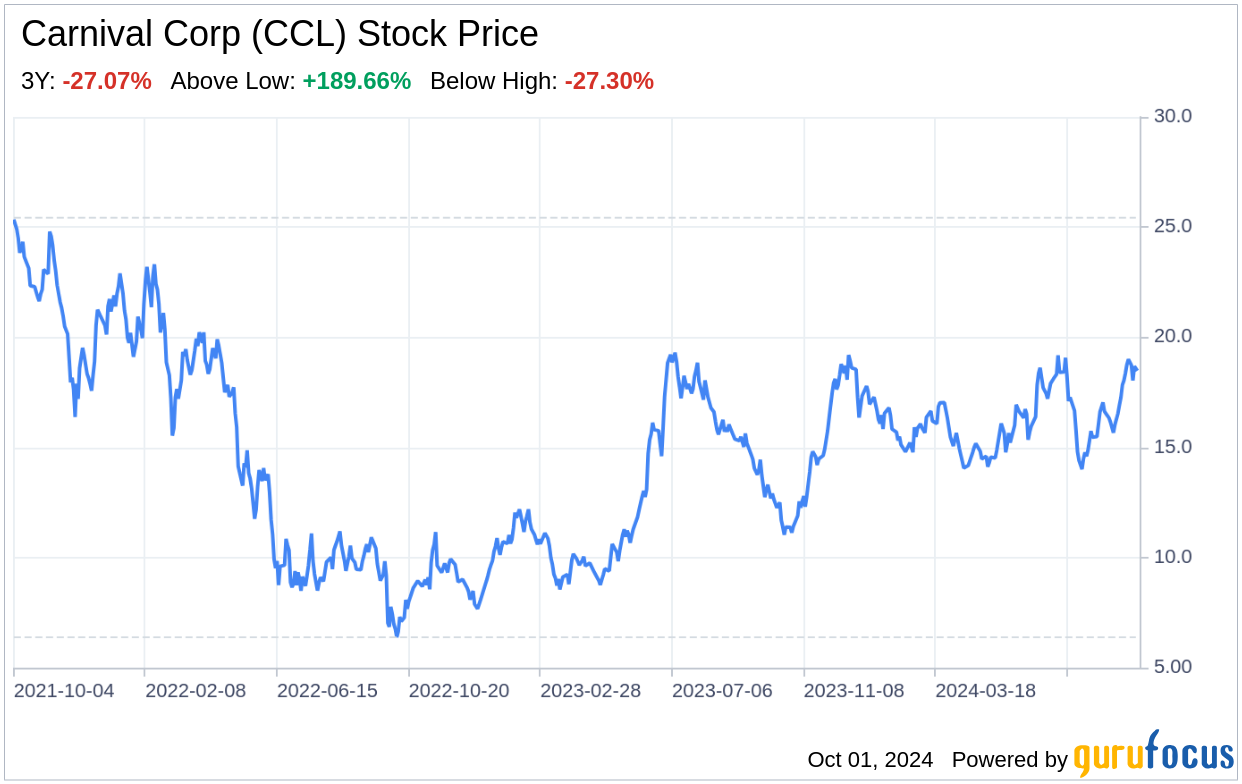As of the third quarter of 2024, Carnival Corp (CCL, Financial) has demonstrated a commendable financial performance, with a notable increase in revenues and operational income. The company's passenger ticket revenue surged to $5.239 billion from $4.546 billion in the previous year, while onboard and other revenues also saw a healthy climb. This uptick in revenue streams has been instrumental in propelling the operating income to $2.178 billion, up from $1.624 billion, reflecting Carnival Corp's adept cost management and operational efficiency. The net income stands at a robust $1.735 billion, a significant rebound from the marginal loss recorded in the prior year. These figures underscore the company's resilience and strategic acumen in navigating the post-pandemic recovery phase.

Now, let's delve into the SWOT analysis of Carnival Corp (CCL, Financial), based on the latest SEC 10-Q filing dated September 30, 2024, to understand the company's strategic positioning and future outlook.
Strengths
Brand Portfolio and Market Presence: Carnival Corp (CCL, Financial) boasts a diverse and powerful brand portfolio, including Carnival Cruise Lines, Holland America, Princess Cruises, and Seabourn, among others. This multi-brand strategy allows the company to cater to a wide range of customer preferences and price points, enhancing its market presence. The company's ability to attract nearly 13 million guests in 2023, matching its pre-pandemic levels, is a testament to the strength of its brands and the loyalty of its customer base.
Operational Efficiency: The significant increase in operating income from $1.624 billion to $2.178 billion within a year highlights Carnival Corp's operational efficiency. The company has effectively managed its operating expenses, despite the inflationary pressures and increased costs associated with the resumption of full operations post-pandemic. This efficiency is reflected in the improved net income figures, which have bolstered the company's financial stability.
Weaknesses
High Debt Levels: Despite the positive financial performance, Carnival Corp (CCL, Financial) grapples with high levels of debt. The company's efforts to manage and service this debt are evident from the repayments of $4.8 billion of long-term debt during the nine months ended August 31, 2024. However, the substantial debt could limit the company's operational flexibility and pose a risk to its financial health in the event of unforeseen economic downturns or industry-specific challenges.
Regulatory Compliance Costs: Carnival Corp is subject to stringent environmental regulations, including the newly implemented EU Emissions Trading Scheme (ETS). Compliance with such regulations incurs additional costs, as seen with the $49 million spent on emission allowances. While these costs were not material for the period ended August 31, 2024, ongoing and evolving environmental regulations could impose further financial burdens on the company.
Opportunities
Industry Recovery Post-Pandemic: The cruise industry is experiencing a resurgence as travel restrictions ease and consumer confidence returns. Carnival Corp's robust recovery in guest numbers indicates a significant opportunity for the company to capitalize on the pent-up demand for travel and leisure experiences. The company's strategic focus on enhancing guest experiences and expanding its fleet can further drive growth in the post-pandemic era.
Brand Realignment: The decision to fold the P&O Cruises (Australia) brand into Carnival Cruise Line by March 2025 represents a strategic realignment that could streamline operations and strengthen the company's core offerings. This move may lead to operational synergies and cost savings, contributing to the company's long-term growth prospects.
Threats
Geopolitical and Economic Uncertainties: Carnival Corp operates in a global environment that is susceptible to geopolitical tensions, economic fluctuations, and other macroeconomic factors. These uncertainties can affect consumer spending and travel patterns, potentially leading to a decline in demand for cruises. Additionally, the ongoing threat of pandemics and other health crises poses a risk to the industry's stability and Carnival Corp's operational continuity.
Competition and Market Overcapacity: The cruise industry is highly competitive, with several major players vying for market share. The risk of overcapacity, coupled with aggressive pricing strategies by competitors, could pressure Carnival Corp's pricing power and profitability. The company must continue to innovate and differentiate its offerings to maintain its competitive edge in a crowded market.
In conclusion, Carnival Corp (CCL, Financial) exhibits a strong financial foundation, with a robust brand portfolio and operational efficiency serving as its core strengths. However, the company must navigate the challenges posed by high debt levels and regulatory costs. The opportunities presented by the industry's recovery and strategic brand realignment are promising, yet threats from geopolitical uncertainties and market competition require vigilant management. Overall, Carnival Corp's strategic initiatives and forward-looking strategies position it well to leverage its strengths and opportunities while addressing its weaknesses and threats in the dynamic cruise industry landscape.
This article, generated by GuruFocus, is designed to provide general insights and is not tailored financial advice. Our commentary is rooted in historical data and analyst projections, utilizing an impartial methodology, and is not intended to serve as specific investment guidance. It does not formulate a recommendation to purchase or divest any stock and does not consider individual investment objectives or financial circumstances. Our objective is to deliver long-term, fundamental data-driven analysis. Be aware that our analysis might not incorporate the most recent, price-sensitive company announcements or qualitative information. GuruFocus holds no position in the stocks mentioned herein.
